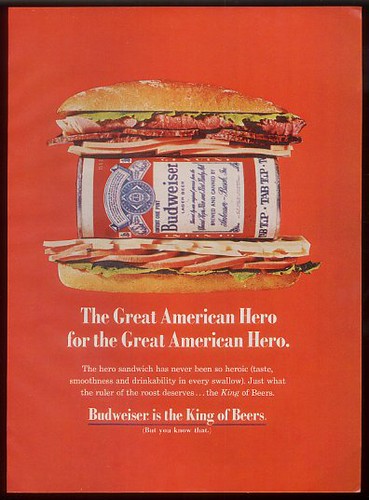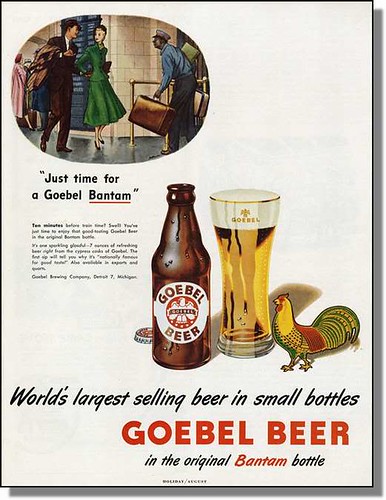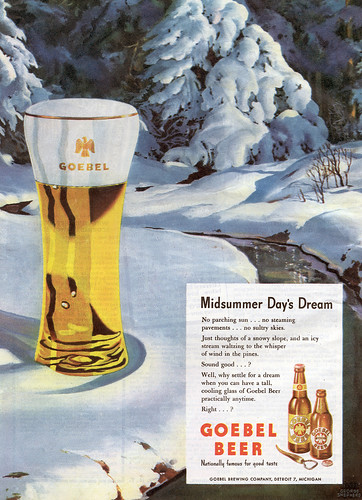
From Darya Pino, founder of Summer Tomato, comes this funny, but ultimately useful chart on How to Find Real Food at the Supermarket. Enjoy.

By Jay Brooks

From Darya Pino, founder of Summer Tomato, comes this funny, but ultimately useful chart on How to Find Real Food at the Supermarket. Enjoy.

By Jay Brooks

Friday’s ad is a 1969 Budweiser ad showing a can of their beer in between a hero sandwich, with the slogan “The Great American Hero for the Great American Hero.” I’m not sure I’d want to bite into that sandwich, I’d be afraid I’d lose a tooth. Or it might taste metallic.

By Jay Brooks

I’d been hearing rumors about how the merger between Gordon Biersch and Rock Bottom was going, and the news wasn’t all good. I’d heard there had been few changes for Gordon Biersch brewers, but that life was getting more difficult for Rock Bottom’s brewers, who were used to having a certain amount of freedom to choose what they brewed. It probably didn’t help that Allen Corey, who had been running Gordon Biersch, became President and CEO of the newly merged company consisting of both brewpub chains, plus a third chain. One chain’s philosophy was bound to be favored over the other.
That all seems to have come to a head, as John Fosyton reports in the Oregonian, the Portland Rock Bottom’s celebrated brewer, Van Havig, has been “asked to leave” the company. Havig had been brewing for Rock Bottom for 16 years and consistently brewed some of the best beer I’ve had at any brewery. Foyston speculates that Havig may have been shown the door for publicly voicing his concerns with the direction the company had been taking since the merger, and primarily the loss of freedom for the brewers, for the first time imposing standardization. That was one of the hallmarks of Rock Bottom, their independence, and was the reason they won so many awards at GABF over the years. That they’re now apparently losing that independence can’t be a good sign for the future of the chain’s beers, if not the chain itself.
But the real loss is Havig. Van’s a terrific brewer and not having him brew for Rock Bottom makes them all the poorer. If you know about a brewing job, preferably in Oregon, drop John Foyston a note and he’ll see that Van gets it.
By Jay Brooks
![]()
You may recall the formerly wonderful beers of Valley Brewing in Stockton, California. That was due to one singular reason, their longtime brewmaster, Steve Altimari. Steve’s beers have became some of the most creative, innovative and diverse of any brewer. He perfected one style after another and brewed some truly experimental gems. His Uber Hoppy Imperial IPA was one of the best and his London Tavern Ale, a delicate English-style mild was a great session beer. But back on June 12th of last year, Steve was summarily dismissed under circumstances that could charitably be termed “odd.” I got the full story a couple of days after that, when I spoke to Steve in New York, where he was vacationing with his family. The owners initially told him that they’d sold the brewery (something he himself had been trying to do at that same time) and that the new bosses no longer needed his services. That tuned out to be not true in the least, and they instead brought in a scab brewer who flew in from Bend, Oregon, apparently, to do the brewing. I’m told they also locked Steve out of the brewery and refused to return his personal property that was there, including beer, barrels, etc. The good news was that since he’d been trying to buy Valley brewery, he already had investors and a management team in place.
So it’s six or so months later, and I’m pleased to announce that Steve’s new brewery — High Water Brewing — has begun brewing. They’ve set up offices and cold storage in San Leandro, California, near Drake’s Brewing, whose brewing equipment they’ll be using to make High Water’s beer. They’re also installing their own fermenters on site but will store the finished beer in their separate offices nearby.

Initially, they’ll be offering three regular beers:
The beers will debut on draft — 5 & 15.5 gallon kegs — in February during SF Beer Week (yet another reason I can’t wait for SF Beer Week!). Packaged beer, in 22 oz. bottles, will follow in early Spring, most likely in April. You can see the new labels on the website. They’re also still seeking additional investors, and if you’re interested, you can read about High Water’s investment opportunities.

In the interest of full disclosure, the name High Water Brewing was suggested by me in a post back in June when this all went down, and after an exhaustive search, my suggestion turned out to be the one they liked best. The founders of the brewery were kind enough to thank me by awarding me some shares in the company, giving me a very teeny tiny interest in the company, essentially a symbolic, but very much appreciated gesture.
By Jay Brooks
![]()
This is only tangentially related to beer, so caveat lector — let the reader beware — and concerns some shenanigans by another breast cancer charity again. You may recall last year, a San Francisco-based one, Breast Cancer Action, threw beer under the bus and told the alcohol community they should be ashamed of themselves for raising money for the worthy cause of breast cancer awareness. In my write-up at the time, Biting the Hand That Feeds You, I remarked about a disturbing trend I’d been noting with large charitable organizations.
I’m really starting to believe that there’s now a “charitable industrial complex,” that these behemoth charities have become big business in their own right. And from what some of you have written, and from what I’ve seen, it appears that, like many big corporations, much of the profits go to the people who run them and only a little goes to shareholders, or in this case to the actual charitable cause itself. They seem to have become more about the money than the well-intentioned passion to do something about an issue that led to their formation.
More proof of my growing uneasiness with behemoth charities came to light recently, this time from Susan G. Komen For the Cure. They’ve started sending out cease and desist letters to over a hundred (possibly hundreds of) smaller charities threatening them with lawsuits if they don’t stop using their trademarked “for the cure” phrase in such organizations as “Kites for a Cure, Par for The Cure, Surfing for a Cure and Cupcakes for a Cure.”
Stephen Colbert Show on January 3 mentioned this in his “Tip of the Hat/Wag of My Finger” segment:
| The Colbert Report | Mon – Thurs 11:30pm / 10:30c | |||
| Tip/Wag – Susan G. Komen Foundation & Spider-Man Musical<a> | ||||
| www.colbertnation.com | ||||
| ||||
Well, the Huffington Post report referenced in the Colbert segment was also sent to me today by Natalie Cilurzo of Russian River Brewing, whose own campaign, All Hopped Up For the Cure, seems destined to get one of these threatening letters, too. After reading Susan G. Komen Foundation Elbows Out Charities Over Use Of The Word ‘Cure’, I think it’s even worse than Colbert’s piece suggested, and that was pretty bad.
The majority of the charities being threatened by Susan G. Komen appear to be small “Mom & Pop” charities with few resources to fight a lawsuit with the big law firms retained by Komen. They’ve apparently been spending a million dollars a year, money they received from donors which ironically did not go toward finding a “cure,” on legal fees alone.
They told one charity that “they own ‘cure’ in a name and we had to stop using it, even though we were raising money for an entirely different cause.” They told another to “never use the color pink in conjunction with their fundraising.” This is what I meant before. This is just bullying, plain and simple. I understand that companies have an affirmative duty to protect what they believe to be their trademarks or brands, but there are ways to do things, and ways not to do things. It’s seems to me that being a bully while at the same time claiming to be a charity could easily be a PR disaster.
What this ends up being about is protecting their own revenue stream, which if they were a “for profit” business would make perfect sense. But when protecting your own revenue stream also means taking money away from other charities, it’s not as black and white any longer, at least not to me. The charitable communities should, I think, be working together toward a common goal, even if they go about it in different ways. Curing cancer should be the only goal that matters, but Komen’s actions seem to show that it’s become more about “who” finds the cure or can muster the most money and resources to shut down their “competition” from using the same effective fund-raising tactics. It’s hard for me to support any charity whose goal seems to be more about the money and power than actually finding a cure.
I don’t care how “legal” their actions are or what side of the law their actions fall on, it still comes across badly. There’s the letter of the law and the spirit of the law. These now behemoth charities used to be about passionately trying to do good work in the world, whether fighting a disease or helping people in need, or what have you. But increasingly they seem no different than any other big business, using their large resources, political clout, etc. to throw their weight around with little regard for their original mission or purpose. As one of the women whose charity’s been targeted, Sue Prom ends the HuffPo article with the following.
“I used to give money to Komen all the time, but now I’m just kind of wary of them,” [Sue Prom] said. “I’m not buying Yoplait yogurt or anything that has the word ‘Komen’ on it. They seem to have forgotten what charity is about.”
By Jay Brooks

Thursday’s ad is yet another one for Detroit’s Goebel beer, from 1948. I figure I may as well keep the inadvertent theme going. I miss the small bottle, which they call a “bantam.” Except for a few extreme beers, you rarely see them anymore. Even Anchor had to abandon that small bottle they used to use for Old Foghorn. I’m told the bottle just became too expensive. But back to the ad. No time to drink 12 ounces? Surely you can drink a 7 ounce bantam weight beer and still make the train.

By Jay Brooks
![]()
Harry Schuhmacher’s Beer Business Daily earlier today published the results of their BeerNet Power 20. Essentially they polled his many beer business subscribers and asked them to vote for the most powerful people in the beer business. It’s the beer equivalent of Entertainment Weekly’s annual power issue. They cut off the voting last night at 5:00 p.m. and stayed up late counting ballots. It’s their first Power 20 poll since 2006, and quite a bit has changed since then. For those on the list in both 2006 and the new ranking, I’ve included their older ranking in parenthesis.
Here’s some observations from Harry about the makeup of this year’s list:
This is the first year that a Busch isn’t on the list. And this is the first year that a craft brewer has achieved the Power 20’s coveted Number 1 poll position: Jim Koch. In fact, in the last Power 20 four years ago, there were only two craft brewers on the list. This year, there are six. And a few Brazilian names have made the list for the first time, and a big investor who is only tangentially in the beer business, Warren Buffet, signaling that readers think he will be a bigger player.
The Top 3 in 2006 were 1) Craig Purser, National Beer Wholesalers Association, 2) August A. Busch IV, Anheuser-Busch Companies, and 3) Bill Hackett, Crown Imports. Curiously, Brewers Association president Charlie Papazian was ranked #13 in 2006, but isn’t on the current list.
By Jay Brooks
![]()
Today in 1912, New Mexico became the 47th state.
New Mexico

New Mexico Breweries
New Mexico Brewery Guides
Guild: New Mexico Association of Small Brewers
State Agency: New Mexico Alcohol and Gaming Division
![]()


Package Mix:
Beer Taxes:
Economic Impact (2010):
Legal Restrictions:

Data complied, in part, from the Beer Institute’s Brewer’s Almanac 2010, Beer Serves America, the Brewers Association, Wikipedia and my World Factbook. If you see I’m missing a brewery link, please be so kind as to drop me a note or simply comment on this post. Thanks.
By Jay Brooks

Wednesday’s ad is another one for Detroit’s Goebel beer, from 1953, and the last of the overtly winter ads I have. I can’t tell you how many times I’ve been driving up to the house in my sleigh just hoping someone would be holding a tray at the window with a freshly-poured beer. It’s good to have dream.

By Jay Brooks

Tuesday’s ad for Detroit’s Goebel beer is presumably meant for the summer, despite showing a winter scene. The “Midsummer Day’s Dream” slogan is the dream apparently brought about drinking a cold brew. Drink Goebels and you’ll be transported to a winter wonderland. Better bring a coat.

